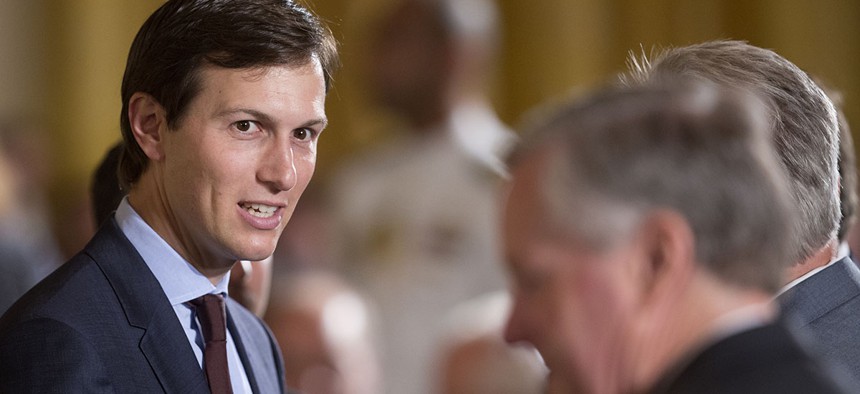Trump's Innovation Office In Close Touch With USDS

Senior adviser to President Donald Trump, Jared Kushner, talks in the East Room of the White House in Washington, Monday, June 5, 2017. Carolyn Kaster/AP
White House tech adviser Chris Liddell attends U.S. Digital Service meetings multiple times a week.
President Donald Trump’s key advisers appear to be deeply involved in government technology teams founded under Barack Obama.
When Trump dedicated a new White House team to modernizing government IT in March, it wasn’t immediately clear how the Office of American Innovation's mission differed from the U.S. Digital Service, a troubleshooting task force for high-profile technology projects.
But senior Trump advisers are regularly attending USDS meetings, signaling their interest in large-scale government technology projects, USDS Acting Administrator Matt Cutts told Nextgov. Cutts joined the federal government last year from Google, where he ran the Webspam team and created a safety filter for the search engine.
» Get the best federal technology news and ideas delivered right to your inbox. Sign up here.
USDS emerged out of a sort of technology SWAT team initially brought in to salvage the rollout of HealthCare.gov under Obama. The team of about 200 technology-savvy professionals, recruited for short-term stints from companies such as Facebook, Google and Amazon, still works on large federal IT projects such as Vets.gov, a consolidated portal where veterans can access online benefits. USDS also has satellite units in other departments including Homeland Security and the Pentagon.
Chris Liddell, formerly Microsoft’s chief financial officer and currently Trump’s director of strategic initiatives, meets with USDS multiple times a week, though his role varies depending on the project, Cutts said.
“When we’re working on service delivery, he’s hearing the latest projects that are out there," Cutts added.
Other times, Liddell and the team discuss policy surrounding technology, Cutts said. Jared Kushner, Trump’s son-in-law and senior adviser who has been tasked with running the Office of American Innovation, also occasionally attends their meetings.
And though the administration may have changed, USDS’ technology portfolio hasn’t, Cutts explained. In the past, the digital service has worked on projects including updating the admissions process for refugees.
“The way we make decisions is the same: what is the impact, how feasible is it and can we use those solutions across government?” he said.
Other White House officials also appear to be on board with USDS’ mission to simplify government buying, Cutts explained. At a recent USDS demo day, for instance, Office of Management and Budget Director Mick Mulvaney talked to several members who had worked in government procurement. One team worked on Hack the Pentagon, a bug bounty program offering money in exchange for surfacing vulnerabilities, which potentially reduced the cost of finding a bug from $13,000 to about $1,100.
Upon learning about their backgrounds, Mulvaney shared he’d witnessed procurement challenges when on a House Small Business Committee, Cutts said.
“Everybody got a hug from the director of OMB," Cutts said. "Which was fantastic, but kind of makes the point that unless you fix the underlying problem of the culture, you’re not going to make anything better.”
The Defense Digital Service team hasn’t shifted gears after the transition, either, Director Chris Lynch told Nextgov. Lynch, credited with leading the Pentagon’s first hackathon, said Defense Secretary James Mattis “has given us even more of a view and has been actively encouraging even more people to come in and work with us and talk to us.”
DDS has doubled in size to about 30 people since the transition, Lynch said, and works with the Office of American Innovation on a case-by-case basis. Most recently, the Office of American Innovation advised the Veterans Affairs Department to sole-source a massive contract for electronic health records, an effort DDS had been working on.
NEXT STORY: Agency FITARA Scorecard Grades Dip





